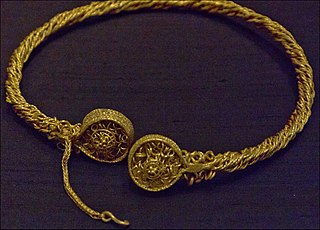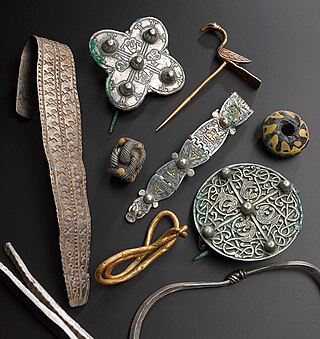The Peebles hoard is a Bronze Age hoard which was found near Peebles, Peeblesshire, Scotland in June 2020. [1] It was discovered by Mariusz Stepien, a 44-year-old hobby metal detectorist, and the find was announced on 10 August 2020. [2] [3] [4]
The Peebles hoard is a Bronze Age hoard which was found near Peebles, Peeblesshire, Scotland in June 2020. [1] It was discovered by Mariusz Stepien, a 44-year-old hobby metal detectorist, and the find was announced on 10 August 2020. [2] [3] [4]
The hoard was discovered on 21 June 2020 by Mariusz Stepien, a 44-year-old metal detectorist, originally from Poland but resident in Edinburgh, who had been metal-detecting for nine years. He was detecting with friends in a field near Peebles, Peeblesshire, when he found the first item at around 10am, 60 centimetres (24 in) below ground level. He immediately reported it to the Treasure Trove Unit and National Museums Scotland. The site was covered with a tent until the professionals arrived. There followed 22 days' work on site, during which Stepien and his friends camped in the field to protect the site and to observe the archaeologists' work, and the finds and surrounding soil were taken to the National Museums Collection Centre in Edinburgh. The find was announced on 10 August 2020. [2] [5]
Professional archaeologists were contacted before the site had been disturbed, allowing the items to be investigated in context and details of the leatherwork to be recorded. Bronze Age findings are rare in Scotland, and the artefacts establish a linkage between the people living there 3,000 years ago and tribes in Northern Germany. [2]

The Portable Antiquities Scheme (PAS) is a voluntary programme run by the United Kingdom government to record the increasing numbers of small finds of archaeological interest found by members of the public. The scheme began in 1997 and now covers most of England and Wales.

The Ewart Park Phase is a period of the later Bronze Age Britain.
The year 2009 in archaeology

The Stirling torcs make up a hoard of four gold Iron Age torcs, a type of necklace, all of which date to between 300 and 100 BC and which were buried deliberately at some point in antiquity. They were found by a metal detectorist in a field near Blair Drummond, Perthshire, Scotland on 28 September 2009. The hoard has been described as the most significant discovery of Iron Age metalwork in Scotland and is said to be of international significance. The torcs were valued at £462,000, and after a public appeal were acquired for the National Museums of Scotland in March 2011.

The Milton Keynes Hoard is a hoard of Bronze Age gold found in September 2000 in a field at Monkston Park in Milton Keynes, England. The hoard consisted of two torcs, three bracelets, and a fragment of bronze rod contained in a pottery vessel. The inclusion of pottery in the find enabled it to be dated to around 1150–800 BC.
The year 2012 in archaeology involved some significant events.

The Grouville Hoard is a hoard of an estimated 70,000 late Iron Age (Celtic) and Roman coins reported in June 2012. They were discovered by metal detectorists Reg Mead and Richard Miles in a field at an undisclosed location in the parish of Grouville on the east side of Jersey in the Channel Islands. It is the largest hoard ever found in Jersey, and the first major archaeological find made by metal detectorists in the island.
The year 2014 in archaeology involved some significant events.

The Galloway Hoard, currently held in the National Museum of Scotland, is a hoard of more than 100 gold, silver, glass, crystal, stone, and earthen objects from the Viking Age discovered in the historical county of Kirkcudbrightshire in Dumfries and Galloway in Scotland in September 2014. Found on Church of Scotland land, the hoard has been described by experts as "one of the most significant Viking hoards ever found in Scotland". With years of extensive study and research, scholars are still not certain who buried the hoard, why they did so and whether they were Vikings or Anglo-Saxons. During the Viking Age, Galloway found itself squeezed between two Viking kingdoms and essentially cut off from other Anglo-Saxons in Britain - "Galloway is where these different cultures were meeting. It’s not just Scandinavians, but people from Britain and Ireland as well."
This page lists major archaeological events of 2015.

The Leekfrith torcs are four Iron Age gold torcs found by two hobby metal detectorists in December 2016 in a field in Leekfrith, north Staffordshire, England. The find consists of three neck torcs and a smaller bracelet, which were located in proximity to each other. They are believed to be the oldest Iron Age gold jewellery found in Britain. Subsequent archaeological examination of the area did not uncover further objects.
This page lists major events of 2019 in archaeology.
Events from the year 2020 in Scotland

The Havering hoard is a hoard of 453 late Bronze-age artefacts found at a site overlooking the River Thames in Rainham, London, in 2018. It is the largest bronze-age hoard to be found in London and the third-largest in the United Kingdom. The discovery was made during an archaeological investigation of the site prior to its use for gravel extraction. The finds included weapons, tools and ingots, but only a small quantity of jewellery. It was unusual in being buried in four separate locations; most bronze-age hoards previously excavated have been concentrated in a single location. Some of the items are from continental Europe, demonstrating links with that region. Several proposals have been put forward for the origin of the hoard, which include a collection of goods for recycling, an attempt by a single individual to control the bronze trade in the area or the large-scale abandonment of bronze goods at the start of the Iron Age. The artefacts are currently on exhibition at the Museum of London Docklands, after which they will be on display at the Havering Museum in Romford.
This page lists major events of 2020 in archaeology.
The Horsehope or Horse Hope Craig Hoard is a Bronze Age hoard found in Scotland in 1864.
This page lists major events of 2021 in archaeology.